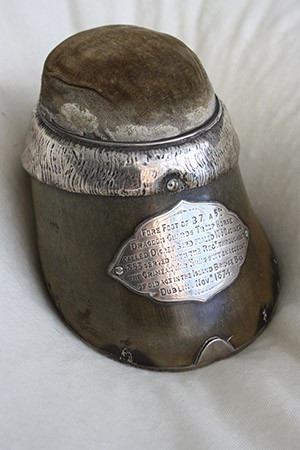Dickie Bird—buried but not forgotten
Published in Artefacts, Issue 6 (November/December 2019), Volume 27By Lar Joye
Clancy Barracks in Dublin, formerly known as Islandbridge Barracks, dates from 1798 and is near the Irish National War Memorial Gardens. Taken over by the Irish Army in December 1922, it was renamed in 1942 in honour of Peader Clancy, killed during the War of Independence. It was sold in 2004, and before being redeveloped it was archaeologically surveyed by Margaret Gowen & Co. Ltd. A plaque on one of the barrack walls read:
‘Near this spot lies the remains of Dickie Bird B7, Troop Horse 5th Dragoon Guards. Which was foaled in 1850, joined the regiment in 1853 and served throughout the entire Crimean Campaign from May 1854 to June 1856. He was shot on the 21st November 1874 by special authority of the Horse Guards, to save him from being sold at auction.’
Archaeologists found Dickie Bird buried with another horse, which was strange, as horses would normally have been sold and then rendered. Besides burying him, the regiment also commissioned a painting of him and removed one of his hooves and turned it into a silver-mounted trophy. Why was he buried in such a way ?

Above: One of the front hooves of Dickie Bird, turned into a silver-mounted trophy. (NMI)
The 5th Dragoon Guards, while not classed as an Irish regiment, were stationed in Ireland from 1685 to 1890 when not engaged in foreign wars. They were involved in suppressing the 1798 Rebellion and are remembered for attacking the rebel camp at Vinegar Hill, Co. Wexford, on 21 June, and later defeating the French at the Battle of Ballinamuck on 8 September.
For most of the nineteenth century the regiment carried out a policing role in Ireland and England, assisting the civilian authorities; in 1838 it was sent to Birmingham to deal with election riots there. At the beginning of 1854, eight cavalry and 28 infantry regiments were stationed in Ireland, and the 5th Dragoon Guards were based in Dublin at Islandbridge Barracks from 1850. When war broke out with Russia, the regiment left what is now Cobh, Co. Cork, on the SS Himalaya on 27 May 1854 to take part in the Crimean War as part of the Heavy Brigade.
Dickie Bird charged with the Heavy Brigade, a much more successful charge than the later and more famous disastrous charge of the Light Brigade. During the winter of 1854 there were no more battles; the war degenerated into a siege of Sebastopol, and many horses died. The regiment lost 347 of their 560 mounts but Dickie Bird survived, returning to Ireland to become a regimental mascot for eighteen years. It would appear that this popular mascot was then given a ceremonial burial and his grave marked with a plaque.
There are two more British military horses buried in Dublin; can readers name them? Answers to ljoye@dublinport.ie.
Lar Joye is Heritage Officer, Dublin Port.
















